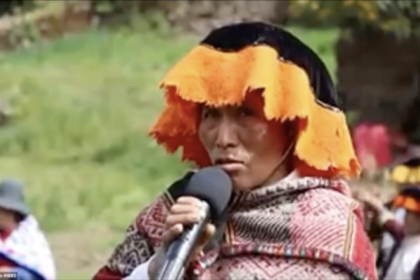UNPACKING “CONSERVATION” PART II: VOICES FROM ABYA YALA
On April 21st, 2022 indigenous community leaders called in from their respective homelands for the second round of the Unpacking Jargon series #3 on Conservation, Protected Areas and Indigenous Homelands: Voices from Abya Yala, hosted by the Swift Foundation and First Nations Development Institute. The paradigm clash of the conservation industry and Indigenous Peoples’ care of their home territories was evoked through ritual, song, dance and story, embodying balance between people and nature.
Alejandro Argumedo, Program Director of Swift Foundation and moderator, dedicated the webinar to Sabino Gualinga, wisdom keeper of the Sarayaku Nation, who passed away two months before. He spoke from the Parque de la Papa in Peru, with community members gathered on the hillside behind him under a mountain blue sky. Lino Mamani, from the community of Pampallackta, then offered three coca leaves to the Apus and Pacha Mama, the sacred mountains and Mother Earth, asking permission from the Apus for this gathering.
To ground the conversation and connect it to part 1, A-dae Briones of First Nations Development Institute, calling in from California, named the long history of conservation that has excluded Indigenous Peoples from their homelands. She explained conservation as an extension of western mainstream society, which has promoted the single idea that some lands can be devastated, and others protected. Only today, we are seeing how lands have been preserved only for future extraction, as more and more protected areas and national parks are being opened up for drilling, mining, and timber. “This is where Indigenous worldviews are so important, because they have continually stated our people cannot be separated from our lands, what is done to our lands is done to us. Western industrial mainstream society has to choose to listen.”
Patricia Gualinga, human rights and land defender from the Kichua Peoples of Sarayaku Nation, and daughter of Sabino, to whom this webinar was dedicated, evoked her father’s memory through song by sharing a recording of him singing. “My father was really salt of the earth, when he spoke everyone listened. He said that if the governments keep drilling, they are just going to destroy Mother Earth and all that will be left is dust. He was a deeply spiritual man who struggled for justice. He could speak with the stones.” Sabino is known for his powerful testimony before the Inter-American Court of Human Rights in the trial of Sarayaku vs. Ecuador, where he testified against the state and won. His message: the forest is alive. Known today as the Kawsak Sacha, or the Living Forest, declaration.
Before speaking next, Daniel Santi Gualinga, lead of the International Relations of the Kichua Peoples of Sarayaku, invited youth from his community to dance. He then turned directly to the topic at hand: “The legacy of our elders teaches us to practice real Indigenous conservation. It is not just a concept of conservation; it is a fundamental principle of life.” Articulated through Kawsak Sacha wherein the forest and “all the life within her as living beings have a right to life,” Sarayaku is now trying to draft a law to recognize their Living Forest in a legal framework with official recognition because “we know that the spirits flee when there is oil drilling and pollution.” He pointed out how the IUCN has more than 8 categories of conservation, none of which have been useful for defending Indigenous Peoples territories, and which only serve the conservation industry and the companies. “We are the defenders of nature. Thanks to our struggle and our wisdom, our territories are intact. Eighty percent of the biodiversity of the world is in our territories precisely because we are successful living in balance with the nature.”
Panelist Maya Choc, Executive Director of SATIIM, a Mayan NGO representing over forty Mayan communities in Belize, named the origin of her organization simply: “Our story began in 1994 when our lands were taken from us and created into a National Park.” This meant her people had to stop their traditional practices of hunting, farming, and spiritual practices, as well as sustainable timber harvesting, all of which maintained the beauty the state sought to “protect.” After tireless work all these years later, formal recognition of the rights to land of the Mayan people has been affirmed, a historic win and reframing of who will manage the protected areas – the Mayan people themselves. At the same time, oil companies have returned, yet again, seeking to drill only now within the very boundaries of the National Park. In the face of this, SATIIM has established a Free Prior and Informed Consent protocol that “reflects the reality of our communities” and which includes the right to dissent, to saying NO, the first of its kind in the Americas.
Back at the Parque de la Papa, Ricardina Pacco, leader from the community of Paru-Paru, and expert on food systems and the defense of heirloom seeds, strolled across the grass to a board with blank paper saying: “I am going to explain to you by drawing how we practice a Quechua concept of Sumak Kawsay, the ‘good life.’” There she drew three circles, explaining each Ayllu, or community – Sallka, Auki and Runa, which translate roughly as the wild, the sacred and the people, and which are interrelated. “These allyus are the pillars of Sumac Kawsay [also known as Buen Vivir], which Latin America has used as a counterpoint to the white man’s development. This requires reciprocity.” This also requires the deep lived knowledge, which Ricardina was clear about, naming the irony of outside biologists hired by the conservation industry to set agendas for Indigenous people, “whippersnappers just out of college, but we have learned about our territories all our lives and really have the deep knowledge.” When asked of the difference between Protected Areas and the Allyu system, Ricardina answered without pause: “In the Allyu system we are free, free to live in balance with nature. In Protected Areas everything is enclosed, fenced off and jailed. Even the animals are jailed. The humans are jailed.”
In closing, Alejandro Argumedo summarized the essence of the shared reflections: “Conservation isn’t about separating nature from human, it is about really living all together in harmony for the good life for the Sumac Kawsay, with clean air and water, with the animals wild and plants and all of us. We should be proud as Indigenous Peoples of these ancestral practices and models and find ways to continue to live in harmony with nature according to these creative ways.”
Suzanne Benally, Executive Director of Swift Foundation, closed with gratitude and this synthesis: “You can’t have conservation and at the same time have extractive industries. That is the problem when we start demarcating land, calling a place a conservation area and then invite extractive industries. Conservation is not about setting aside land for conservation and being able to say, well, we set this aside so Indigenous People can continue their lifeways. It is about our cosmovision, our living spaces, about this concept of life, it is about Indigenous Peoples voices. Our rights – legal and spiritual.”
As embodied by all speakers, this spiritual understanding wherein “conservation” is one embedded aspect of a holistic vision for living life in a good way, with people in harmony with nature, is enduring in its efficacy and wisdom.


